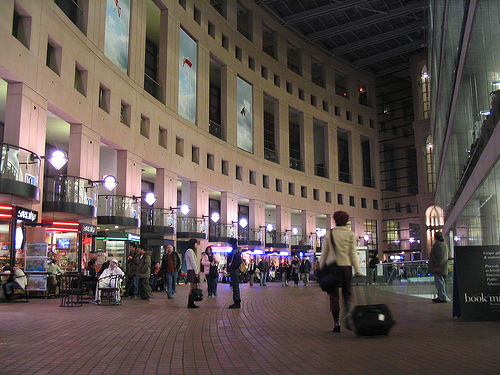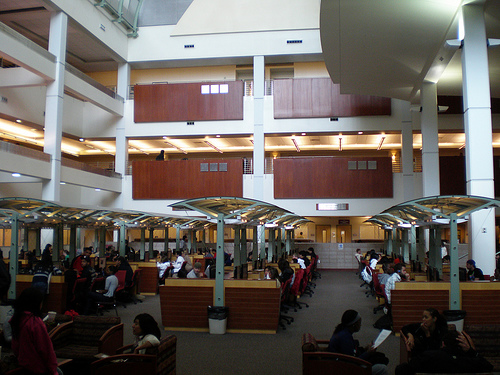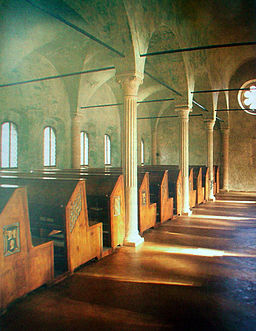Author’s Note: When I first started this project I was planning on doing an infographic. I figured it would be the best medium to convey the infiltration of the visual on literacy. However, it turns out my academic tendencies lean strongly to text, since in order to organize my infographic I ended up writing an essay. I still wanted to try something new, hence the accompanying infographic opening my essay. It’s not quite what I had in mind when I started out, but caused me to push my own visual literacy boundaries.
Figure 1: The Evolution of Libraries. Created using easel.ly.com
As technology evolves, so does the role of the library. While some functions, such as private study, are still viable, the library has grown in its services to students and the public. The shushing librarian is a thing of the past. Libraries are now community-centred and the physical spaces grow and morph with the needs of the patrons rather than the number of books. While stacks of reference material still prevail, technology is now a main focus. In fact, they are not just reference centres, but also a place to grow and learn information communication literacy. In other words, people do not just come to study they also come to learn, collaborate and socialize with the librarians, instructors and each other. Many of these changes are in response to society’s need for multiliterate and information communication technology savvy individuals.
In the past, libraries did not even exist. This is difficult to fathom because they are so prevalent today and recent history. Keep, McLaughlin and Parmar (1995) describe early texts, or palimpsests, as manuscripts that were erased and reused for writing over again. Early writing was not coveted or preserved; practicality was important, and vellum was expensive. Furthermore, most cultures were oral, rather than textual, and ideas, knowledge and stories were preserved via storytelling (Ong, 2002). Even Plato railed against the fallacy of writing in the Phaedrus, claiming that writing will lead to forgetfulness (Postman, 1992). Libraries came into existence as the creation of parchment, and later paper, became easier and writing a more accepted form of “memory” storage. Libraries have always and still do focus on two things: service and spaces. It is the definition of these two things that has changed in response to the digital technologies valued by our society.
Traditional Libraries
The original service role of a library was that of a book reference centre only. In fact, the root word of library (libr) means book, emphasizing its importance (library, n.1, 1902). Libraries originated from monastery collections, which were used to encourage dogma among monks, but not the public (Vais, 2012). Even when libraries expanded to the cathedrals and colleges emphasis was placed on books and private study. This is not surprising, considering illiteracy was rampant. Reading was done only by the upper class and production was for church or court (Keep et al., 1995). In fact, during the Middle Ages the upper class was in the habit of writing their own manuscripts and sharing among each other rather than the library (Keep et al, 1995). Most library books were those of science, philosophy and theology and important books were made accessible to all by chaining them to desks (Vais, 2012; Saenger, 1997). Chained books were later removed in the eighteenth century as improved printing led to cheaper books, increased literacy and patrons’ preference for mobility in their reading (Vais, 2012).
As for library space, there was place for private study, but space was only modified to make room for more books (Vais, 2012). Often there was a place for scribes called a scriptorium, denoting another function of libraries. McLuhan describes study carrels of the Middle Ages as “singing booths” because they were often used for dictation. If there was a scriptorium, it was often below the library for security (Vais, 2012). Libraries were a “Meeting point between books and readers” (Vais, 2012, p.57) and not much else.
Today’s Libraries
The traditional library description is vastly different than today’s definition of library service and space. In her research Ercegovac (1997) found while 86% of patrons search the library catalog and 60% borrow or return books, they were also using the library for instructional services (34%), instructional sessions (51%) and reference questions (45%). In the advent of the Internet patrons are also using it for databases (67%) and electronic journals (72%). While these numbers might not be so surprising, how the library space is now used is. Private study is still the number one use (69%) (Ercegovac, 1997) (51-64%) (Given & Leckie, 2003). However, Given and Leckie’s (2003) more recent research shows the space is also used for writing (18-24%), meeting friends (27%), talking to other patrons (12-20%) and using the computer (13-15%).
Given and Leckie (2003) postulate the lower numbers in social uses of the library is due to traditional perceptions of libraries, but point out the increasing popularity shows the need to provide spaces for them. More than ever, libraries are requiring space for breakout rooms and social study space (Marks & Findley, 2005). Some libraries, such as the Las Vegas LIED library provide stackable chairs and movable carts in order to create impromptu collaborative spaces (Marks & Findley, 2005). And if this seems unconventional, some libraries even provide prayer rooms (Bayliss, 2012) and food courts or coffee shops (Given and Leckie, 2003). The idea is the library is more than just a study space, but a place for social interaction and gathering. Libraries are not shrinking; they are growing to accommodate the needs of the community (Boone, 2002).

Figure 3: Vancouver public library concourse. The foyer to this library is a social space containing cafés and retail shops. (Kacharhook, 2005).
The physical reading material in libraries has even morphed from the traditional book. Visual literacy, which is defined as the “ability to decode and interpret…visual messages and also to be able to encode and compose meaningful visual communications” (Gross & Latham, 2007, p. 103; Spalter and van Dam, 2008) is prevalent in today’s world. A clear example is the graphic novel, which breaks free of enclosing panels and is longer than of a typical comic book (Keep et al, 1995). It is a hybrid of comic and novel that did not exist even 50 years ago. Bolter (2001) argues visual literacy challenges print literacy because it “claim[s] to achieve greater immediacy and authenticity by integrating images (and sound) with prose” (p. 47). Movement towards visuality can also be connected to the fact that, compared to medieval times, today’s society is largely literate. In fact, Bolter (2001) goes further to describe the present as “postliterate” (p. 55), meaning we are rising from the push for literacy into a new era where visuals are more ubiquitous than text. An educator’s role is to help teach visual literacy because youth are bombarded with and involved in the production of visual materials, but do not always have the skills to assess it. Libraries provide access and instruction to accommodate this.
However, the New London Group (2000) argues more vehemently for not just visual literacies, but multiliteracies, and libraries are providing for this as well. Multiliteracy accounts for more than reading, writing and seeing. Rather, it includes multimedia and information technologies as well as context, such a culturally, linguistically and globally diverse societies (The New London Group, 2000). Dobson and Willinsky (2012) maintain the evolution of digital technologies over the past few decades has directly influenced perceptions of literacy. The word processor provides for conceptual and collaborative work and hypermedia encourages critical thinking, accessibility and “blurs the boundary between reader and writer” (p. 5). Alexander (2002) expands on this idea further in his claim that Web 2.0 “represents a conceptual shift accompanied by blurring and hybridity” (p. 152). Libraries are now a hub for digital technologies. Most have anywhere from 8-80 computers (Bayliss, 2012) and Internet access is usually ubiquitous (Boone, 2002). Some argue there is an issue with finding space for both technology and books (Boone, 2002; Marks, 2005). However, Ercegovac’s finding that low numbers of patrons are using computers in the library begs the question: is it due to the lack of computers or is there another reason? Seadle (2002) purports the portability of objects, such as laptops, tablets and mobile devices, means libraries should forgo pre-laptop seating. Patrons want to be comfortable, have light and look out a window. As well, ergonomics matter because people are sitting and typing for longer periods of time. Hard-wired technology, such as screens and projectors, should be found in teaching and meeting spaces, but common areas need flexibility.

Figure 4: The University of Las Vegas Lied Library. This library has a large computer commons and social spaces on the main floor and reference material on the upper floors. (Shari, 2009)
Regardless of set up, libraries are taking a role in providing space and service related to multiliteracies. Most librarians offer instructional session specifically on information communication techonology (ICT) literacy, and research shows it is necessary. Gross and Latham (2007) discovered students often believe they have better ICT skills than they do, and the greatest perceptual disparity lies in those with the lowest levels of ICT. Research subjects reasoned because they confidently use ICT in their lives they could do it for academic research. However 45% of students entering higher education tested as non-proficient in ICT literacy. The most common response for how they have become ICT literate is ‘self taught,’ illustrating the inconsistency of ICT skills being taught in K-12. Libraries help fill this gap by providing instruction on how to find and evaluate resources.
As mentioned above, part of ICT literacy is knowing how to find appropriate information when needed, and a library’s capacity to index has been greatly increase by networked technologies. In 1945 Vannevar Bush dreamed up the Memex; a machine capable of creating trails between items. Bush criticized the lack of knowledge transmission due to having too much to sift through. It is difficult to find what is needed when indexing systems use artificial classes and subclasses, and items can be in only one spot. In other words, it is more beneficial to have “selection by association rather than indexing” (Bush, 1945, par. 53). Who knew his idea would come to fruition in the form of the Internet and tagging. In terms of the library and ICT, librarians help patrons with database searches daily. Patrons can enter a title, author, subject or even just a keyword and potentially find what they are looking for. With some basic training, one can become proficient in finding appropriate materials in a relatively quick manner. However, what is most interesting is not only does it exists but is used by most individuals. Alexander (2009) comments on the prevalence of tagging, or folksonomies, to label microcontent by many Internet users. This is vastly different from ancient and middle ages when the public majority was illiterate and uninvolved. Today’s focus on literacy as well as easily accessible technologies in private and public space has empowered users to not only digest, but collaborate, create and index information online. Thanks to the work of users, indexing is not just done by the worlds’ libraries anymore.
Conclusion
Libraries have evolved over the years, and most recently in response to digital technologies. They are not just a place for private study, but also a place to collaborate, receive instruction and even socialize. The physical spaces reflect the needs of the community, whether it is the general public or the school population. As well, the services reflect the growing demand for citizens to be multiliterate and confident and efficient with information communication technology literacy. As technology continues to evolve the nature of the library surely will evolve too.
References:
Alexander, B. (2006) “Web 2.0: A new wave of innovation for teaching and learning?” Educause Review, 41(2), 34-44. Retrieved, April 5, 2008, from http://www.educause.edu/ir/library/pdf/ERM0621.pdf
Bayliss, S. (2012). How social media built a library. Library Journal, 5/15/2012 supplement, 34-34.
Boone, M.D. (2002). Library design: the architect’s view. A discussion with Tom Findley. Library Hi Tech, 20(3), 388-392.
Bush, V. (1945). As we may think. The Atlantic Monthly, 176(1), 101-108. Retrieved October 17, 2009, from http://www.theatlantic.com/unbound/flashbks/computer/bushf.htm
Bolter, J.D. (2001). Writing space: Computers, hypertext, and the remediation of print [2nd edition]. Mahwah, NJ: Lawrence Erlbaum.
Ercegovac, Z. (1997). The interpretations of library use in the age of digital literacies: Virtualizing the name. Library and Information Science Research, 19(1), 35-51.
Given, L., Leckie, G. (2003). “Sweeping” the library: Mapping the social activity space of the public library. Library and Information Science Research, 25, 365-385.
Gross, M., Latham, D. (2007). Attaining information literacy: An investigation of the relationship between skill level, self-estimates of skill, and library anxiety. Library and Information Science Research, 29, 332-353.
Kacharhook, N. (2005). Vancouver public library concourse, retrieved November, 24, 2012 from http://www.flickr.com/photos/k9/84108898/
Keep, C., McLaughlin, T., & Parmar, R. (1995). The electronic labyrinth.* Available: http://www3.iath.virginia.edu/elab/hfl0261.html
“library, n.1”. (1902). In OED Online. Retrieved from http://www.oed.com/view/Entry/107923?rskey=n3rcOU&result=1.
Marks, K., Findley, T. (2005). Lied library at the university of Nevada, Las Vegas: Post-construction thoughts. Library Hi Tech, 23(1), 16-21.
Metros, S.E. (2009). The educator’s role in preparing visually literate learners. Theory Into Practice. 47(2), 102-109.
New London Group. (2000). A pedagogy of multiliteracies: Designing social futures. In B. Cope and M. Kalantzis (Eds.), Multiliteracies: Litearcy learning and the design of social futures (pp. 9-39). Youth Yarra, Australia: MacMillan.
Ong, Walter. (1982.) Orality and Literacy. New York, NY: Routledge.
Postman, N. (1992). Technopoly: The surrender of culture to technology. New York: Vintage Books.
Saenger, P. (1997). Space between words: The origins of silent reading. Stanford, CA: Stanford University Press.
Vais, G. (2012). The house of books: The metamorphosis of the library space (Middle Ages). Philobiblon: Transylvanian Journal of Multidisciplinary Research in Humanities, 17, 50-63.
Seadle, M. (2002). The physical dimension of information space. Library Hi Tech, 20(1), 6-7.
Shari, M. (2009). UNLV-Lied library ground floor [photograph], retrieved November, 24, 2012 from http://www.flickr.com/photos/hamsters/3587903759/
Spalter, A.M., van Dam, A. (2008). Digital visual literacy. Theory Into Practice, 47(2), 93-101.
Uomodis08. (2009). Malatestiana 3 [photograph], retrieved November, 24, 2012, from http://commons.wikimedia.org/wiki/File:Bibl._Malatestiana_3.jpg




In his book, “Writing Spaces” Bolter expresses that writing technologies and especially electronic writing, in all its changing forms, play a significant role in how a culture continuously seek to redefine itself. More specifically, Bolter states, “because of their representational functions, media in general must always be among the most important metaphors that we have to express such changes” (2001, p. 189). Though this concept does not necessarily describe the exact same thing, reading about how libraries have evolved over time reminded me of that because they not only continue to change so as to adequately represent the present culture but also often house the electronic media that Bolter was referring to.
More specifically, as explained in this commentary, many libraries today have become a much more open environment that promote communication and socialization in addition to learning through its physical layout and multimedia offered among other things. This of course is in comparison to the more traditional libraries that were once commonplace wherein its primary function was to store resources for reading, research or leisure but did not encourage or stimulate much else. With that said, in taking a more broad view of these differences it is much more apparent that each greatly echoed the type of culture of its time since the older versions were quite fitting to the more traditional methods in education and even within the public whereas the new library models depict the current trends of communication, collaboration and multiliteracies.
Bolter, J. D. (2001). Writing space: Computers, hypertext, and the remediation of print. Taylor & Francis.
You point out that libraries “echoed the type of culture of its time.” I definitely saw this in my research. For example, before the printing press books were hand written, big and expensive—hence they were chained to library desks so no one could steal them. However, the creation of the printing press led to book being printed more cheaply and becoming more pervasive. This made chained books seem silly and unnecessary, and because the culture began to value to the portability of books it also probably seemed obtrusive. I can’t help but notice, however, we still treat our large reference books with similar reverence. Often they are in a special section in the library and they can’t be taken out on loan. Or, if they are important and also expensive, often there is just one copy and it’s behind the circulation desk. With the advent of ebooks this is slowly changing, but not quite. Depending on the publisher, some ebooks are sold on a licence base. This means even though it is electronic and we should all be able to access it as long as we have library access, if you “take it out” I can’t see it. With all the discussion and changes to copyright law in Canada and the shift towards copyleft and open resources I wonder if this will eventually change. Will it be a cultural shift and will publishers and libraries evolve with it? Knowledge for all! Viva la revolution!